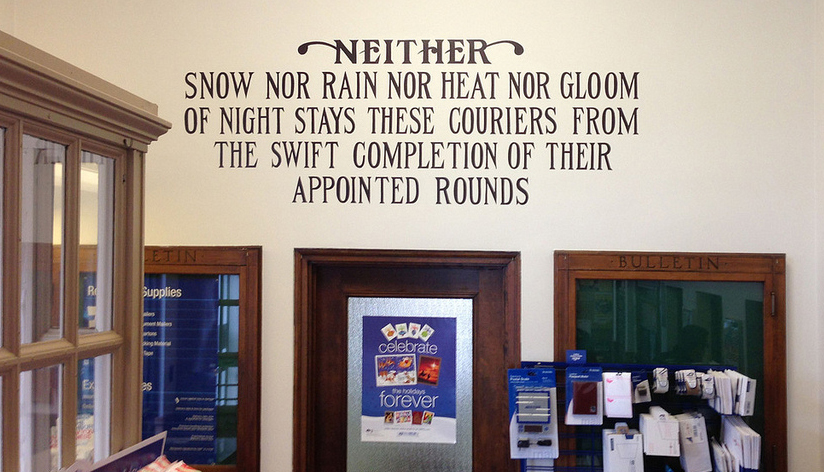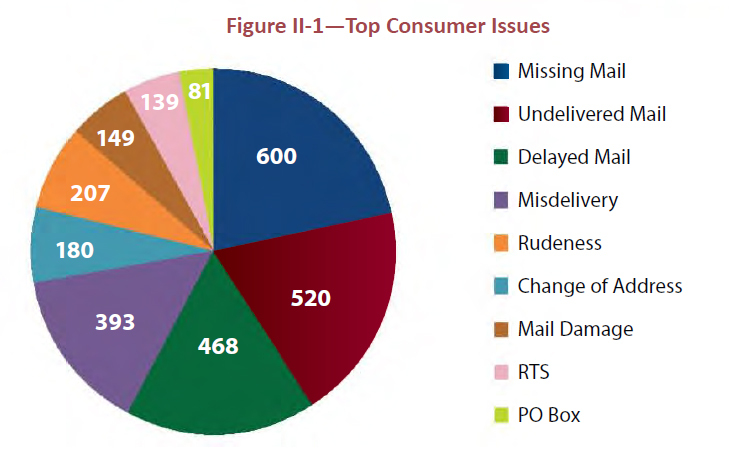Postal Regulatory Commission Chairman: Helping Customers Through The Mega-Bureaucracy Of The Mail Since 1998

(bikeoid)
The post office might be one of the most incomprehensible bureaucracies in the country. It is, on the one hand, a massive network spanning every state, county, and city in the nation. It is also, on the other hand, hyper-local: for most of us, letter carriers literally come right up to the front door six days a week.
When it works, it works amazingly. Less than fifty cents to get something from Boston to Juneau in a few days without having to think about it? That’s some pretty sharp infrastructure. But when it doesn’t work well, consumers can find themselves in a circle of bureaucratic hell even deeper than the DMV.
Enter the Postal Regulatory Commission. The PRC’s mission, basically, is to keep the Postal Service in line. They approve mail rate increases and they make sure the USPS follows its own rules and regulations. They also can be a recourse for customers who can’t get what they need from the postal service.
Chairman Ruth Goldway, the head of the Commission, sat down with Consumerist this week to explain what the PRC’s role is, why some bad service keeps happening, what elements are working as intended, and how the United States Postal Service could evolve with tighter resources in an increasingly digitally-oriented world.
The system is working as intended…
The Post Office might be big and slow, but it’s still a remarkable system, chairman Goldway said. “The US has 40% of the world’s mail,” she explained, and the post office is “a robust and heavy-volume system that works, on the whole, pretty well. I think we should be proud of that.”
Although that system may not always reflect what individual consumers want to see, for the most part it does exactly what it’s designed to do. You may sometimes have a hard time trying to buy stamps or send a letter, but your individual business is, well, very individual.
Individual consumers aren’t the biggest movers of the mail. The USPS takes almost more of a business-to-business approach to their work. “Most of their focus is on the big mailers dropping hundreds of thousands or millions of pieces of mail into the system and getting those delivered to you very quickly,” Goldway said. When a year’s worth of tax forms start rolling in at the end of January, it’s easy to see what she means.
Along the edges, though, some of the deliberate choices the USPS has made in how they serve individual customers frustrate many. Does your mail come at 6, 7, or 8 p.m.? That’s not your letter carrier having trouble with their route. That’s just the reality of what they’re bringing to your house these days. “They want their delivery people to be at the office when the Amazon packages arrive,” Goldway said.
Cutbacks have also forced rearrangement. Mail now comes in to local stations later than it used to due to reduced capacity farther upstream in the network. That means letters and packages are in the hands of workers to deliver to the homes on their routes later in the day, too.
…Except when it’s not.
The PRC received about 2600 rate and service complaints last year, according to their 2013 annual report (PDF). The biggest issue consumers write or call in about? The mail not going where it’s supposed to, when it’s supposed to. Missing, misdelivered, late, or undelivered mail complaints form just over half the bunch. Rudeness (from USPS employees) comes in 5th.

PRC 2013 Annual Report (PDF), p. 9
Chairman Goldway explained that the USPS has been putting in more measures to track where the mail is actually going, and when. Those bar codes printed on the front of envelopes by the time you get them in your hands? Those are part of a system that allows the postal service to track mail from drop-off to delivery, and helps them identify bottlenecks or where in the system items go astray.
As for the face-to-face customer service interactions at your local post office, those are a slower change. Formerly, USPS employees got promoted into customer-facing post office day shift jobs based on seniority and performance in sorting centers–a completely different kind of work, that may not always have trained them for a full day of essentially retail interaction.
Recently, Goldway said, the postal service “has been trying to improve the training for those people, and adjust the decisions that are made about who gets the jobs.” But, she added, “they’ve also severely cut back on the number of clerks–so the level of personal interaction is not that good. And they have not been very innovative in terms of developing better customer processes.”
So are things getting better with time and recent changes? Maybe. Because the metrics keep changing, it’s hard to tell. “With regard to customer service, it’s a little harder for me to say what the trends are, because the postal service has changed its measurement systems several times in the last four or five years. So you can’t compare apples to oranges,” the chairman explained. She added that this year will use the same measurement tools as last year, though, “so we might be able to see some trends that we hadn’t before.”
Those trends, however, are very high-level information: the data comes in at a national level. The PRC doesn’t get to see it broken down, even though complaints do differ significantly by region. So if all’s well in Chicago but terrible in San Diego, that’s something the PRC will have trouble tracking.
How can we fix it?
The PRC can only give as much guidance as the information it has. “What gets measured gets paid attention to,” Goldway said, and so the first step to fixing a system is having clear data about that system.
When individuals contact the PRC with a rate or service issue, a real person answers the phone. After the PRC has received the report, they forward it to the USPS. The USPS is supposed to respond, allowing the PRC to then respond back to the individual, within 45 days.
The responses aren’t always what a consumer wants to hear, but the PRC does follow up with a random sample. “We contact people who complain to us and ask them how satisfied they are with the service they’ve gotten from the postal service,” Goldway said, “and we use some of the information we get from these complaints to get an anecdotal sense of how service is developing.”
But again: the PRC can’t help consumers with issues that it doesn’t know they’re having. They aggregate reports to generate bigger pictures, and if they aren’t getting complaints about an issue, it may as well not exist.
Chairman Goldway urged customers to work with their local post offices as much as possible when they have an issue. Your local post office has a regional consumer affairs office, and that’s the first place you should head, Goldway said.
If you’re not satisfied with the outcome from dealing with the consumer affairs office, though, “then one alternative is to come to us,” said Goldway. “We will, with the consumer specialist who is in our office, try and underline those complaints, so they’re more likely to be heard.”
The PRC can’t guarantee anyone the resolution they want, because the postal service gets to make final calls, but, “we try to work as an additional voice for the consumer, over and above” the consumer affairs office.
Chairman Goldway admitted that her position can be a frustrating one. She advocated for the adoption of the Forever stamp, she said, and added, “I’d like to be the advocate for other solutions to problems. So if people have thoughts about that, I’m happy to hear them. We just can’t promise that we can solve the problems,” she said, because the regulatory law under which the PRC operates limits their powers. “Not the powers I’d like,” Goldway acknowledged, explaining that their job is to make sure the postal service follows its own rules and procedures, not to write new ones.
“It’s frustrating for us. But we do have some review, and to the extent we raise these issues in the public domain of Washington, DC and get the ear of people in Congress, we can make a difference as well.”
Where do we go from here?
To the generation who have now grown up so plugged in that even e-mail and IMs feel like dinosaur tech, the post office feels like an irrelevancy. And right now, it may mostly be. But Goldway has hopes for the postal service’s ability to continue adapting to the future.
The USPS isn’t just a mail service, Goldway said–it’s a giant network of under-used community agencies: “I’ve been a strong advocate of trying to use post offices for more than just the mail, for seeing them as community centers for use by other government agencies or other activities. I’d like to see the postal service use its network in more than one way.”
Goldway suggested putting technology in the hands of letter carriers to let them communicate back and forth with individuals on their routes as one possible way of better using those community connections. She also suggested animatedly that post offices would be an excellent resource for reaching the unbanked, lower-income Americans who need safe, secure access to basic financial services.
In the meantime, chairman Goldway encouraged the public to make their rate and service complaints, to contact the public advocates working on current cases, and to attend public meetings to make their voices heard. We may all complain about the mail, but it only stands a chance of getting better if you complain to the people who can fix it.
Want more consumer news? Visit our parent organization, Consumer Reports, for the latest on scams, recalls, and other consumer issues.

